Nespresso vs espresso: What's the difference and which is best?
Their names may be similar but there are key differences between Nespresso and espresso coffee

Coffee type: Beans
Water tank capacity: 67 Fl oz
Dimensions: H16.4 x W12.9 x D14.1 inches
Weight: 23lbs
The Breville Barista Touch Impress is a seriously impressive coffee maker that stands out for its touch screen, high customisability, and its skill at frothing different types of milk. Despite its wide range of features, a guided menu helps lower the learning curve while its built-in grinder and puck system make it feel like you're a pro. It's great for beginners and experts alike, and the rapid heat-up and intelligent grinding are highlights.
Pros
- Guided menu with touch screen
- Grinder and puck system remembers your settings
- Ability to froth different types of milk
- Runs quietly
Cons
- Expensive
- May be overkill; for coffee experts

Coffee type: Nespresso Vertuo pods
Water tank: 25.4 Fl oz
Dimensions: H10.4 x W14 x D8.6 inches
Size: 7.9lbs
The Nespresso Vertuo Pop+ is a versatile coffee maker with five cup sizes and hot and cold coffee options. It's compact, easy to use thanks to its one-touch operation, and has a 30-second heat-up time. The machine is compatible with more than 40 Nespresso Vertuo capsules.
Pros
- One-touch operation and auto-emptying feature
- Compact and sleek design
- Fast brewing time
- Delicious coffee with a thick layer of crema on top
- Offers a range of size options and strength ratings
Cons
- Vertuo pods are less widely available and more expensive than others
- Does not have a milk function, and adding milk can dilute the coffee's ideal temperature
- Sticks out further than desired due to the water tank
When it comes to making coffee, the debate around espresso machines and pod coffee makers, like the best Nespresso machines, can be as rich and complex as the drinks they produce.
On one side, the best espresso machines are the closest you can get to an authentic barista-style coffee brewing experience at home. They give high levels of control and customizability and tend to cater to purists who enjoy the art of making coffee as much as drinking it.
On the other side, the best pod coffee brands prioritize convenience and consistency. They promise a hassle-free experience and this makes them a firm favorite among busy coffee fans who don't want to sacrifice taste for time.
But which is the best coffee maker for you?
In our Nespresso vs espresso guide, we take a look at the key differences between the two techniques — from flavor to convenience and cost — in a bid to help you make an informed decision that meets your tastes, needs, and budget.
This guide compares two of the most popular coffee-making techniques but if you want to learn more about the wider options, we've previously explained how to choose a coffee maker. It covers everything from pod to drip, pour-over, and more. All with advice from the experts.
Nespresso vs espresso: What's the difference?
Despite having almost identical names, Nespresso makers and espresso machines have very different features and costs, and produce different types of coffee-based drinks.
The exact differences depend on the machines you choose, and the beans/pods you use but there are some general distinctions.
Sign up to receive the latest news, reviews, buying guides and deals direct to your inbox
All Nespresso machines — from the Vertuo Pop right up to the Vertuo Creatista – use capsules of pre-filled coffee grounds. They are part of the wider range of pod coffee brands, which also include the likes of Keurig, Bruvi, and Nescafe Dolce Gusto. Nespresso machines are designed to offer convenience and consistency at an affordable price.
By contrast, espresso machines involve a more hands-on approach. You can grind your own coffee grounds from beans, or use store-bought grounds. This gives more control and customizability to the coffee-making experience but requires a higher level of patience and skill. This customizability also comes with a higher cost, but the trade-off is typically richer and more nuanced coffee.
Nespresso vs espresso: Brewing technology
Regardless of the machine you use, coffee is made by passing hot water through coffee grounds. It's how these machines handle the process that determines how your coffee tastes.
Nespresso machines use a patented extraction system that pulls coffee from pre-filled pods. These pods, or capsules, contain pre-measured coffee grounds and each one has been engineered to make different coffee drinks — from lattes to cappuccinos, macchiatos and more.
Each machine contains a chamber where you insert one of these single-serving pods. Once the pod is in place and you close the chamber, the machine punctures the foil lid. This allows hot water to pass through the coffee grounds inside. The water extracts the flavors from the coffee grounds as it flows through, and the resulting brewed coffee is dispensed into a cup. You can read more about how pod coffee machines work here.
Espresso machines extract coffee in a similar way, but instead of relying on pre-measured pods, they use coffee grounds.
You can either grind the desired amount of grounds using a grinder, or you can manually weigh the amount of pre-ground coffee. Some espresso machines, like the Breville Barista Express Impress and the De'Longhi La Specialista are what's known as bean-to-cup makers. This means they have a grinder built into the machine that uses fresh beans to grind the grounds on demand. Alternatively, you can buy standalone grinders, like the OXO grinder for $97 on Amazon, to grind the beans separately.
Once the coffee grounds are in the portafilter, you tamp them down to create a "puck" of compressed coffee. An espresso machine will then force hot water through this puck using pressure to extract the perfect espresso shot.
Verdict: The advanced nature of espresso machines gives them the edge when it comes to judging the two techniques on their brewing technology. It requires more patience and skill but it's worth the extra effort.
Nespresso vs espresso: Price
Nespresso machines range in price, from the $129, entry-level Vertuo Pop+ to the advanced, $849 Creatista Pro. The Lattissima range sits in the middle, with the Lattissima One coming in at $399.
It is also possible to buy Nespresso machines from partner brands. De'Longhi, for example, sells a range of coffee makers that are compatible with the Nespresso pods. The De'Longhi Nespresso Lattissima Single-Serve Espresso Maker is $199, while the Nespresso Lattissima Touch Espresso Machine from De'Longhi has a milk frother and costs $529.
You then need to factor in the price of the pods. A pack of 50 pods can cost anywhere between $70-$85 at Amazon. Individual pods retail for around $1.25, or you can buy a sleeve of 10.
Espresso machines are often seen as a luxury item and can cost as much as $24,000, in the case of the LaCimbali S60, although you can buy more simple models for as low as $150-$200. This includes the Geek Chef Espresso Machine or the De'Longhi ECP3120 Espresso Machine.
Realistically, however, espresso machines cost between $700-$800 for models like the Breville Barista Express Impress up to $3,000-$4,000 for machines such as the Breville Barista Touch Touch.
Espresso machines often require additional accessories like a grinder, a milk frother, or even a coffee scale. These can add to the overall cost of the machine. You'll also need to factor in the price of coffee beans or grounds, and potential maintenance costs.
Verdict: Nespresso machines are almost always the cheaper option due to their relatively simple function and features. This lower number of moving parts helps reduce the initial outlay, while also reducing the risk of expensive repairs.
That said, with espresso machines, you get what you pay for. The advanced features and precision engineering coupled with the deep customizability they provide are worth both the time and cost investment. They're statement pieces and their price reflects that.
Nespresso vs espresso: Flavor & customizability
One of the biggest criticisms from coffee purists about Nespresso pods is that the coffee lacks the rich, robust, and nuanced flavor you can get from grinding beans on an espresso machine.
Coffee experts will always say that grinding coffee beans, on demand, when the beans are fresh helps to maximizes their flavor. Being able to then adjust grind size, water temperature, and pressure helps fine-tune this extraction further. This can lead to a more well-rounded flavor, with a thicker crema and a richer body – but it can also go the other way. There is so much more that can go wrong with an espresso machine and this can result in your coffee tasting worse than instant.
By comparison, Nespresso's capsules have been engineered to produce the best, uniform taste time after time. These capsules are airtight to maintain the coffee's freshness until they're punctured. The precision of Nespresso machines then makes sure you get the optimal pressure and temperature. As a result, the coffee still tastes rich and smooth, and it tends to be more consistently well-balanced than on an espresso machine. If you opt for one of the more expensive Creatista models, you can also access "Barista-style recipes" to introduce a bit more nuance. However, across the board, the flavor with pods can be less intense because of the lack of true customization.
You're also limited to just the flavors available via Nespresso's pods but this is a minor point because there are dozens of options for both the Vertuo and Original machines. Many third-party brewers, including Starbucks, have partnered with Nespresso to create one-off or specialist pods. Plus, the chances of you being able to make a Maple Pecan, Roasted Hazelnut, and Golden Caramel coffee — which are just a selection of the pods available — by yourself, on an espresso machine, are slim.
Verdict: Espresso machines are the best way to extract flavor from coffee beans and if you're a coffee purist, this will appeal the most. That said, although espresso machines offer more nuanced and customizable flavor profiles, they're much harder to achieve than with the Nespresso machine. If you're a big fan of flavored coffees, Nespresso machines offer much more variety, and if you prefer consistency over nuance, then pod coffee will suit you better.
Nespresso vs espresso: Design & Features
The starkest differences between Nespresso machines and espresso makers are in their respective designs and features.
Nespresso machines are typically more compact. They require fewer moving parts and have been designed to fit on kitchen countertops and in smaller spaces. By removing the equipment needed for storing and grinding beans, tamping the grounds and even getting rid of the pucks, Nespresso machines are streamlined and lightweight. This capsule system also makes Nespresso machines easier to clean and maintain.
Nespresso machines often have one-touch systems or they come with guided programmable menus for different coffee sizes, from espresso shots to larger cups. They're also largely made of plastic and come in a range of colors and designs.
Advanced models, like those in the Original range and in particular the Creatista Plus and Pro, are the closest you'll get to espresso machines in terms of features and design. They combine pod coffee brewing with milk frothers and customizable settings to mimic the espresso experience without the steep learning curve.
Traditional espresso machines are then larger and heavier due to the fact they have a more classic, professional appearance. They're often made of stainless steel and are designed to evoke the feeling of being in a coffee store. As a result, they take up more countertop space. In this way, espresso machines are almost used as a sign of status; they're designed to stand out and form the heart of the kitchen, not blend in.
Most of the best espresso machines offer a range of manual controls, including adjustable temperature settings, pressure gauges, and steam wands for frothing milk. Some have built-in grinders, others don't, yet all this added functionality can mean cleaning and maintaining your espresso machine is more complicated compared to Nespresso machines.
Verdict: Nespresso machines are deliberately, and almost unashamedly, simple. They strip out or simplify many of the advanced features seen in espresso machines without sacrificing too much on taste. They're also more compact and subtle. Yet, despite their large size and more complex features, espresso machines are the professional and classy choice.
Nespresso vs espresso: Convenience
Nespresso machines are designed for simplicity and convenience. The pre-packaged nature of the pods not only speeds up the brewing time, but it removes the need to measure coffee or handle messy grounds.
Many pod coffee machines offer guided settings, making them hassle-free, and they produce consistent results with minimum effort. Nespresso machines also heat up quickly and require minimal cleanup, making them the most convenient of the two machines.
Espresso machines are harder to use and harder to clean. It takes time to experiment with grind size volume, and pressure levels. Heat-up times are typically longer, as are extraction times. However, for many, this is a major part of the appeal. The process of making coffee can be as enjoyable as drinking it and, if this is you, you'll quickly get frustrated with the convenience of Nespresso machines.
Verdict: This one depends largely on your lifestyle and interests. If the act of drinking coffee is what matters, then Nespresso machines will be your best bet. If you enjoy the process of making coffee as much as the taste, opt for an espresso machine.
Nespresso vs espresso: Our verdict
Nespresso and espresso are so different in terms of price, style, design, features and flavor that they each appeal to very different groups.
If you're short on time, short on space, want consistent and hassle-free coffee, or you're on a budget, Nespresso machines will suit you best. They're designed to be simple and what you lack in bells and whistles you get back in convenience.
For everyone else, espresso machines are the best bet. You need patience, more space and a larger budget but the pay off in terms of barista-style coffee at home is worth the time and financial investments.

Victoria Woollaston, with nearly 20 years of experience, has reviewed gadgets, beauty tech, and household appliances for WIRED, TechRadar, and Expert Reviews. She specializes in critiquing coffee makers and small appliances for Top Ten Reviews. Victoria is also the founder and editor of inclusive beauty and grooming sites mamabella and MBman.
